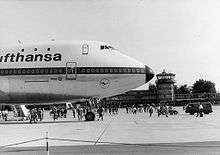Lufthansa Flight 540
 The aircraft involved shortly after delivery to Lufthansa. | |
| Accident summary | |
|---|---|
| Date | 20 November 1974 |
| Summary | Design flaw, flight crew error |
| Site |
Jomo Kenyatta Int'l Airport Nairobi, Kenya |
| Passengers | 140 |
| Crew | 17 |
| Fatalities | 59 |
| Injuries (non-fatal) | 55 |
| Survivors | 98 |
| Aircraft type | Boeing 747-130 |
| Aircraft name | Hessen |
| Operator | Lufthansa |
| Registration | D-ABYB |
| Flight origin |
Frankfurt Airport Frankfurt, West Germany |
| Stopover | Jomo Kenyatta Int'l Airport |
| Destination |
Jan Smuts Int'l Airport Johannesburg, South Africa |
Lufthansa Flight 540 was a scheduled commercial flight for Lufthansa operated with a Boeing 747-100, carrying 157 people (140 passengers and 17 crew members). The flight was operating the final segment of its Frankfurt–Nairobi–Johannesburg route. On 20 November 1974 it crashed and caught fire shortly past the runway on takeoff. This was the first fatal accident and third hull loss of a Boeing 747. This was also the third fatal accident involving a wide-body aircraft, after Eastern Air Lines Flight 401 in 1972 and the crash of Turkish Airlines Flight 981 earlier in 1974. To date, it is also the deadliest plane crash to occur on Kenyan soil.
As the aircraft was making its takeoff from runway 24 at the Jomo Kenyatta International Airport in Nairobi, the pilots felt a buffeting vibration. The captain continued the climb and retracted the landing gear. However, as this was being done, the aircraft started to descend and the stall warning system light came on. The aircraft continued to descend and approximately 3,700 feet (1,100 m) from the end of the runway, the 747 grazed bushes and grass. It then struck an elevated access road and broke up. The left wing exploded and fire spread to the fuselage. Of the 157 people aboard, 55 of the 140 passengers and 4 of the 17 crew members were killed.
Cause
The cause of the crash was determined to be a stall caused by the leading edge slats having been left in retracted position. Even though the trailing edge flaps were deployed, without the slats being extended the aircraft's stall speed was higher and the maximum angle of attack was lower. As a result, the aircraft was unable to climb out of the ground effect. The flight engineer was found to have failed to open the slat system bleed air valves as required on the pre-flight checklist. This prevented bleed air from flowing to the 747's pneumatic slat system and, since the leading edge slats on the 747 are pneumatically driven, kept it from deploying the leading edge slats for takeoff. The take-off warning system that would have sounded an alarm due to the flaps not being lowered did not have a separate warning that the slats' pneumatic valve had not been opened by the flight engineer.
The faulty state of the slats should by design have been indicated by yellow warning lights: one for the pilot, and eight for the flight engineer. However, both crew members stated in court that these lights had been green. Three possible explanations have since been offered for this inconsistency: that the morning sun was blinding the cockpit crew and thus hampered color perception, that a construction error could have caused green lights despite the retracted slats, and that the crew lied. None of these possibilities could be conclusively proven.[1][2] The flight crew was blamed for not performing a satisfactory pre-take-off checklist, but the accident report also faulted the lack of adequate warning systems which could have alerted the crew to the problem.[3] Two previous occurrences of this error had been reported, but in those cases the pilots had been able to recover the aircraft in time. After this third deadly incident, Boeing added systems to warn pilots if the slat valve had not been opened prior to takeoff.
See also
- British European Airways Flight 548
- Northwest Airlines Flight 255
- LAPA Flight 3142
- Spanair Flight 5022
- Delta Air Lines Flight 1141
- Mandala Airlines Flight 091
Bibliography
- Moorhouse, Earl (1982). Wake Up, It's a Crash! The story of the first ever 747-Jet disaster. A survivor's account. London: Corgi. ISBN 0-552-11932-6.
The final report is this work:
- "Report on Accident to Boeing 747 Registered D-ABYB which occurred on 20th November 1974 at Nairobi Airport, Kenya." East African Community Accident Investigation Branch (Nairobi), 1976. Worldcat entry.
References
- ↑ Spaeth, Andreas. "Lufthansa-Unglück 1974. Absturz nach 35 Sekunden" [Lufthansa Accident 1974. Crash after 35 seconds]. Der Spiegel (in German). Retrieved 20 November 2014.
- ↑ "Grün oder Gelb" [Green or Yellow]. Der Spiegel (in German). 33 (8). 19 February 1979.
- ↑ "Case Study: Lufthansa - Flight 540 - Boeing 747-130, November 20, 1974" (PDF). Blue Skies: GainJet Aviation Safety Magazine. GainJet Aviation (3).
External links
- Accident description at the Aviation Safety Network
- Photos of the crashed airliner from AirDisaster.com
- Pre-crash photos of the airliner at airliners.net
- Cockpit Voice Recorder transcript and accident summary
Coordinates: 1°19′09″S 36°55′39″E / 1.3192°S 36.9275°E